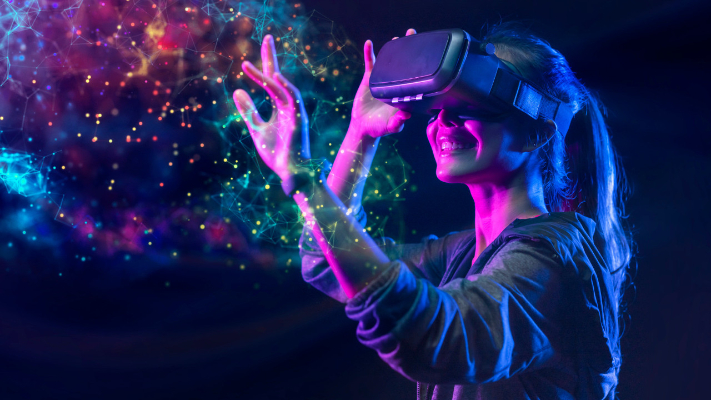In the dynamic landscape of technology, Virtual Reality (VR) and Augmented Reality (AR) have emerged as transformative forces, reshaping the way we work, play, and interact with the world around us. In the year 2023, these immersive technologies continue to evolve, finding applications that span a multitude of industries. From virtual meetings to personalized training, 3D visualizations, immersive gaming, and entertainment, the possibilities seem boundless. This article delves into the key areas where VR and AR are making a significant impact in 2023.
Understanding Virtual Reality (VR)
Virtual Reality is a fusion of software and hardware technologies that immerse users in a computer-generated, three-dimensional environment, replicating real-world surroundings. It leverages tools like motion sensors and VR headsets to transport users into fictional or simulated realms. VR, in essence, replaces reality with a software-generated illusion, serving a myriad of purposes.
Recently, VR has gained remarkable popularity as it transforms social interactions without limitations. It provides a risk-free, lifelike environment, opening up new possibilities in education, medicine, research, and manufacturing.
Demystifying Augmented Reality (AR)
Augmented Reality, as the name suggests, enhances the user experience by overlaying computer-generated elements onto the real world, creating an interactive and immersive environment. Unlike VR, which substitutes reality with illusion, AR supplements real-world surroundings with virtual components. AR harnesses display technologies, cameras, sensors, and software to create this experience. It is increasingly integrated into smartphones, headsets, smart glasses, and tablets.
Top 5 Applications of VR and AR in 2023
- Online Gambling and Computer Gaming
The convergence of VR and AR has ushered in a new era of immersive gaming experiences. In the realm of online gambling, operators are integrating these technologies to provide users with a virtual casino environment. Players can engage in games like online pokies, blackjack, roulette, and baccarat, all within a virtual casino that replicates the real-world experience. Users interact with fellow players, mirroring the social aspects of physical casinos.
An exemplary application of AR in gaming is exemplified by Pokémon Go. The game employs real-time data, GPS, gyroscopes, and cameras to superimpose virtual Pokémon creatures into the player’s real-world environment, seamlessly blending reality with virtual elements.
- Healthcare and Medical Training
VR and AR are revolutionizing medical education and practice, offering a safe and immersive platform for medical students and professionals. Simulations allow medical aspirants to gain hands-on experience without posing any risks to patients. Surgeons can practice complex procedures and virtual surgeries, honing their skills and enhancing decision-making abilities.
AR plays a pivotal role in the healthcare sector, allowing professionals to utilize digital overlays during medical procedures. This enables real-time access to medical imaging, patient records, and vital signs, minimizing errors and improving patient outcomes. While the potential of VR and AR in healthcare is immense, challenges such as availability and cost remain significant barriers.
- Architecture and Design
In the field of architecture, VR and AR enable professionals to translate their creative visions into tangible representations. These technologies facilitate the creation of 3D visualizations, offering architects and designers a comprehensive view of their projects before execution. Users can explore these models from various angles using smartphones, tablets, or smart glasses.
Virtual tours are another breakthrough, enabling investors to virtually explore construction projects without physical presence. VR and AR redefine communication between professionals and investors, particularly in the real estate industry, by incorporating augmented visualization and enhancing creativity.
- Tourism and Hospitality
The integration of VR and AR has revolutionized the tourism and hospitality industry, enhancing the traveler’s experience. Virtual tours and 360-degree videos enable travelers to explore destinations and accommodations from the comfort of their homes. Real-time information on tourist sites, hotels, and points of interest aids in travel planning.
Onsite tourists can access previously inaccessible locations, such as historic buildings and ancient ruins, through digital overlays and real-world data integration. As the industry continues to embrace VR and AR, the potential for transforming the travel experience is substantial.
- Retail and E-Commerce
VR and AR have redefined customer experiences in the retail and e-commerce sectors by offering immersive 3D representations of products. Shoppers can virtually explore stores, mimicking an in-person visit, and visualize products to assess their fit, functionality, and design. This technology empowers customers to make informed decisions before making purchases.
Both online and brick-and-mortar stores leverage VR headsets and devices for interactive product demonstrations. Whether shopping online or in physical stores, VR and AR aim to provide users with a more comprehensive understanding of products, thereby enhancing the shopping experience.
Conclusion
Virtual Reality (VR) and Augmented Reality (AR) are transformative technologies that continue to evolve and diversify their applications in 2023. While VR immerses users in simulated environments, AR enriches real-world experiences by overlaying digital elements. Across diverse industries, these technologies empower users to bring their ideas to life, whether it be through immersive gaming, medical simulations, architectural visualization, travel exploration, or enhanced shopping experiences. As VR and AR continue to advance, their potential to reshape our world is both exciting and limitless.

